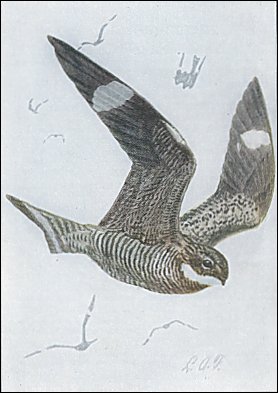

Boy, you sure have a big mouth! An insult, right? Depends. If you're the object of the comment, undoubtedly. However, there are critters that would take this as a compliment. Snakes might, because as many of you know, they can swallow prey larger than their head. That's kind of cheating, though, since they have to dislocate their jaws to do it. On the other hand, nighthawks might swell with pride. After all, their livelihood depends on it. These graceful birds sweep their insect prey from the air. Last-minute evasive action on the part of the insect, or even errant air currents, have the potential to turn supper into a miss. A big, open mouth helps avoid such culinary disasters. But nighthawks aren't satisfied with this. As extra insurance, bristles fan out around the mouth opening, scooping any potential escapee into the bird's gullet.
The cavernous mouths of these birds have so impressed rural people that
the myth grew up that nighthawks suckled milk from livestock at night, accounting for
the common name of their family group—the Goatsuckers.

![]()
Contributor: Arthur H. Harris, Laboratory for Environmental Biology, Centennial Museum, University of Texas at El Paso.
Desert Diary is a joint production of the Centennial Museum and KTEP National Public Radio at the University of Texas at El Paso.

Painting of nighthawk by Louis A. Fuertes. Although the beak looks small, the mouth actually extends back to beneath the eye. From Henshaw, 1921.
Henshaw, H. W. 1921. The book of birds. Common birds of town and country and American game birds. National Geographic Society, 195 pp.